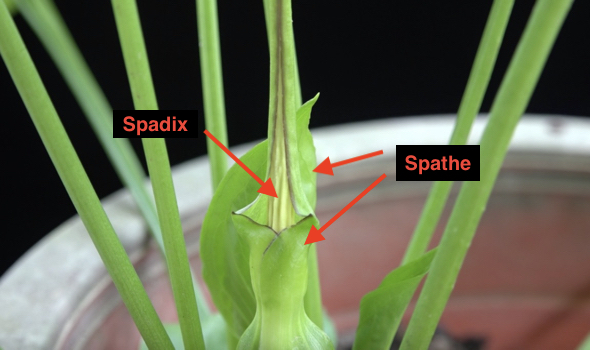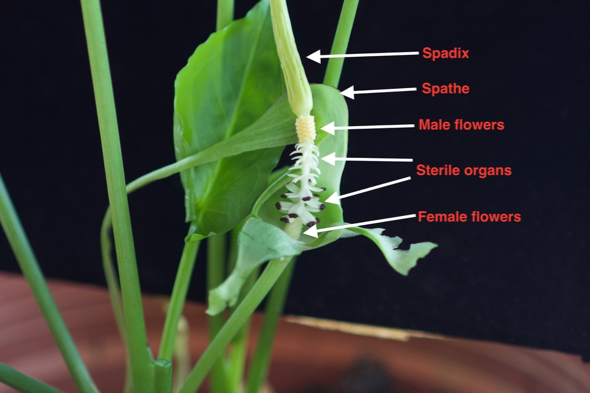
The inflorescence is a slender tapering structure of about 20 cm long with a bulbous base. It is made up of a flowering spike (spadix) totally covered by a large bract (spathe). As the inflorescence matures, the sheathing spathe begins to split open at the base (above) creating an opening into the bulbous base below.
![Typhonium divaricatum fl Araceae [wyc] - 1](https://besgroup.org/wp-content/uploads/Typhonium-divaricatum-fl-Araceae-wyc-1.jpg)
Soon the entire spathe dislodges from the spadix, leaving a larger opening at the neck of the bulbous base (arrowed, above).

Cutting open the base of the spathe exposes the flowers (above). At the base of the spadix is a narrow band of female flowers. Above this are two types of projecting structures that are actually sterile flowers. And above these are a of yellowish male flowers.
Usually the spathe unfolds from the spadix around afternoon. At the same time a fragrance is released by the spadix to attracts pollinating insects. In this case they are tiny gnats (any of many species of tiny flying insects belonging to the order Diptera that comprises true flies LINK. The video clip below shows gnats entering the inflorescence cavity where the flowers are.
These tiny gnats, carrying pollen from another inflorescence where they earlier visited, land on the wall of the bulbous inflorescence base. Because the wall is waxy and smooth, the gnats slide inside where they are trapped by the intertwining sterile flowers. Trapped among the female flowers, the gnats invariably transfer pollen on their bodies on to the stigmas of the female flowers. The flowers are thus pollinated.

By the next few days, the sterile flowers will have wilted, thus allowing the trapped gnats to escape the chamber (above, below). By this time the male flowers above the chamber would have shed their pollen that will cover the escaping gnats. The escaping gnats will fly to the inflorescence of another plant and repeat the process (above, below).
As far as I am aware, so far researchers have only found beetles as the pollinating agent of Typhonium LINK1; LINK 2; LINK 3 and LINK 4. Moth Flies (Diptera: Psychodidae) as pollinating agent, as elaborated here, may well be something new.
YC Wee
Singapore
28th November 2017
References:
1. Meeuse, B.J.D. 1961. The story of pollination. New York: The Ronald Press Company. 243pp.
2. Sivadasan, M. 2005. Flowering phenology and beetle pollination in Theriophonum infaustum N.E.Br. (Araceae). Journal of the International Aroid Society (AROIDEANA Vol 28, p. 104-112). PDF.








